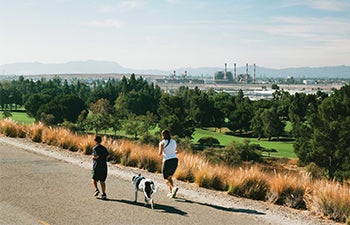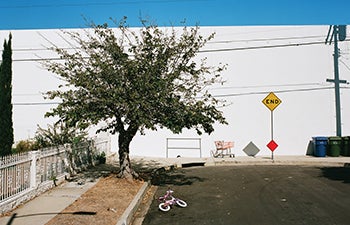
‘Our Voices Have Been Heard’
The early morning hour was taking its toll on Maria Guzman as she stood near a freeway underpass in Pacoima, Calif. As the sun rose and traffic chugged by, she diligently recorded her coordinates with a Global Positioning System receiver. The numbers ticked up on her handheld air monitor. Guzman noted the air-quality levels.
She frowned.
“Most people in this neighborhood don’t realize what the polluted air does to your health,” Guzman said.
The mother of two knows all too well. Guzman, who resides in nearby Sylmar, lived in Pacoima for many years. Her son and daughter suffered from severe asthma in their youth. She wants to ensure that other children and families are not affected by toxic emissions.
A health promoter at the environmental health and justice nonprofit Pacoima Beautiful, Guzman and a team of volunteers took turns monitoring air contamination levels in their communities. Trained by Manuel Pastor, director of the Program for Environmental and Regional Equity (PERE) at USC Dornsife, and James Sadd, professor of environmental science at Occidental College, they did this eight times a day for one week as part of a community-based participatory project called Ground Truthing — finding facts on the ground about the true state of local air pollution.
Pacoima is nestled in the northeast corner of the San Fernando Valley, hugged by long stretches of the 5, 118 and 210 freeways.
Clusters of residential streets lined with single-story ranch houses alternate with roads dotted with signs advertising tire services, auto body shops, custom granite countertops, plastering services and car batteries for sale. The small community, covering approximately seven square miles, also contains an airport and a scrap metal recycling plant. At the community’s eastern border is the Los Angeles Department of Water and Power’s Generating Station in Sun Valley. A few blocks from an elementary school, planes constantly arrive and depart from an airport.
“I know these are not things that are good for the environment, especially when you have a school nearby with little kids,” Guzman said. “When their lungs are growing, it’s really, really bad.”
Low-income communities of color, like Pacoima, are particularly at risk because they are more likely to live close to air pollution sources. Studies show such communities have higher risk and incidence of cancer and respiratory illnesses such as asthma. According to the Los Angeles Times Mapping Project, roughly 85 percent of Pacoima’s population is Latino and median annual household income is $49,000, though the majority of households earn less than $40,000 a year.
PERE, together with community organizations and researchers throughout L.A. — the Los Angeles Collaborative for Environmental Health and Justice — have dedicated their efforts to providing fair and equitable protection from environmental and health hazards for all, a movement known as environmental justice. The Ground Truthing program Guzman participated in was part of a collaborative effort toward policy change to protect vulnerable communities.
It is one example of many PERE projects promoting change.
Led by Pastor, PERE is a research center focusing on issues of regional equity, social movement building and environmental justice. PERE’s goal is to move research from university halls to public policy by partnering with change agents on the ground — such as Guzman’s work with Pacoima Beautiful — to help improve communities.
“We don’t change the world, we work with people who change the world,” is among PERE’s slogans.
“Our fundamental motivators are issues of social justice and inclusion,” Pastor said. “We have found that the environment is something everyone thinks should be enjoyed universally, so understanding inequity in exposure to environmental hazards helps people to see that inequity may exist in other aspects of society — access to education, jobs, etc. — and that it is structural and should be remedied.”

PERE is contributing to a plethora of research projects that address environmental justice — a term used to describe fair and equitable protection from environmental hazards such as pollution from generating plants — for all.
Under the approach of what Pastor terms the “new three Rs” — rigor, relevance and reach — PERE provides the foundational research central to making a case for action. Staff expertise includes data analysis, urban planning, racial equity, grassroots organizing and policy development. Falling in line with the program’s mission, every report produced by PERE is made freely available to the public online.
Pastor launched PERE when he joined USC Dornsife’s faculty in 2007. A long-time advocate for environmental justice and regional inclusion, he wanted to continue his work as a faculty member at the University of California, Santa Cruz, and before that at Occidental College in Los Angeles, Calif.
The professor of sociology and American studies and ethnicity also co-directs USC Dornsife’s Center for the Study of Immigrant Integration (CSII), which gathers data to understand the plight and impact of immigrants as they acclimate into American life. CSII and PERE share much of the same staff, which, in addition to professional data analysts, includes undergraduate and graduate student researchers.
Tiffany Pereira, an environmental studies major who earned her bachelor’s degree from USC Dornsife in 2011, had never heard the term “environmental justice” until Pastor presented on the topic in one of her courses on sustainability.
“I didn’t know much about it, but it really struck me because growing up in Los Angeles, we are in an environment that’s so intertwined with the urban landscape,” Pereira said. “It’s something most people don’t think about.” That summer she worked with PERE as a student assistant, participating in a program that brought local high school students to the USC campus to teach them about environmental justice.
Pereira said students got fired up.
“Wait, is this going on in my community?” they asked her incredulously.
PERE is contributing to a number of research projects that tackle environmental justice concerns in Los Angeles from different angles. Collaborating with researchers from the University of California, Berkeley, Occidental College and elsewhere, they have created a body of research investigating what’s known as the climate gap, the way vulnerable communities are disproportionately affected by climate change. They have also contributed to pivotal research helping to produce more solar power in L.A. (see sidebar below). In addition to environmental justice concerns, they have produced a large body of work on regional equity — reducing socioeconomic disparities — and social movements.
The program’s efforts recently made a huge leap forward in L.A., as well as at the state level.
The data gathered by the Ground Truthing teams in Pacoima and five other toxic hotspot communities — Boyle Heights, Figueroa Corridor, Wilmington, Commerce and Maywood — showed that there were more hazards in closer contact with sensitive populations, such as children and the elderly, than indicated in state and federal databases, as well as significant locational errors when pinpointing hazards. The communities’ research also revealed that air pollution levels regularly exceeded safety standards recommended by the state. Their conclusions were published in a 2010 report called “Hidden Hazards.”
Those findings became the basis for a land use and planning proposal called Clean Up Green Up, which would look at the cumulative effects of environmental pollutants produced by businesses. The status quo was considering each pollution source individually. Clean Up Green Up would create green zones in Pacoima, Boyle Heights and Wilmington, where polluters would be targeted for tougher inspections and enforcement. Businesses would receive resources to help them green up, by providing technical assistance to help them understand environmental rules and acquire green technology.

The Ground Truthing effort in Los Angeles’ toxic hotspot neighborhoods determined that groups such as children and the elderly are more susceptible to health hazards than indicated in state and federal databases.
In June 2013, the Los Angeles City Council moved the plan forward by directing the L.A. City Planning Department to research, analyze and draft the Clean Up Green Up policy. It was a major victory for environmental justice.
Guzman said she was incredibly proud of the progress made since those early mornings measuring air quality. “I’m 100 percent sure there will be many changes as a result of this policy,” she said.
Reyna Hernandez, a volunteer with Pacoima Beautiful who also participated in Ground Truthing, said that while it’s just the beginning, it was rewarding to see the Clean Up Green Up proposal coming to fruition.
“We know our voices have been heard,” Hernandez said in Spanish. As a 17-year Pacoima resident, she sees environmental awareness building. More people are participating in community cleanups, she said, adding, “I’m hopeful for the future.”
While there is progress on the local level, PERE’s research has made inroads at the state level as well.
The technical model for Ground Truthing was an environmental justice screening method developed for statewide use by Pastor, Sadd and their longtime collaborator, UC Berkeley professor Rachel Morello-Frosch. The California Air Resources Board (CARB), the part of the California Environmental Protection Agency dedicated to protecting residents from air pollutants, had commissioned the trio to identify vulnerable California communities.
“What was really innovative about their work was that they used a science-based approach to mapping environmental justice communities throughout the state,” said Álvaro Alvarado, manager of the Health and Ecosystems Assessment Section of CARB. The screening method scores neighborhoods’ proximity to hazards as well as their health risks, social vulnerability indicators and land use designations. The information collected is then presented visually on a map that can be used in citing, zoning and policy development processes identifying overburdened communities, as was done to inform the Clean Up Green Up policy.
Their screening technique became a template for CalEnviroScreen, the California Office of Environmental Health Hazard’s environmental justice screening method. The method will be used on a statewide level to identify communities overburdened by environmental hazards. California’s Global Warming Solutions Act of 2006 stipulates that overburdened communities must benefit from investments in greenhouse gas reduction methods.
Ask Pastor what he thinks of the progress that PERE has made so far, and he says simply that there is always more work to be done.
“It’s never enough,” Pastor said, “But we’ve made good progress at becoming a trusted ally for community groups and a trusted source of facts and information for agencies, academics and others.”
Moving forward, PERE wants to make a larger impact on the world and at the university, he said.
Michele Prichard knows this can happen. The director of Common Agenda at Liberty Hill, an L.A.-based foundation advancing social change, has worked closely with PERE on many ventures, including the Ground Truthing project.
“The fact that their research has been informed by the voice of the community is very unique and special,” she said. “PERE’s researchers have really been willing to go outside the traditional arenas of laboratories and libraries. They investigate and understand the problems from many different facets, including the people on the ground.”
Read more stories from USC Dornsife Magazine‘s Fall 2013-Winter 2014 issue